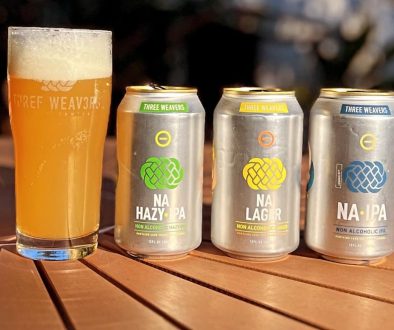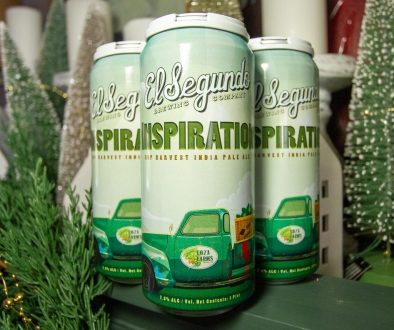Good Ideas Executed Poorly: The Brewers Association Chases Independence
On June 27th, The Brewers Association (BA), craft beer’s not-for-profit trade group, announced a new initiative in their effort to promote independent, craft-brewed beer with an Independent Craft Beer Seal that can be placed on bottles and cans “in an effort to educate beer lovers about which beers are independently produced” (you can read the press release here). The seal immediately garnered criticism for its design as well as its intent. The upside down bottle and the BA’s description for it overshadowed the sentiment.

“Featuring an iconic beer bottle shape flipped upside down, the seal captures the spirit with which craft brewers have upended beer.” Unfortunately, it also captures the spirit of the BA’s efforts to define and maintain their definition of independent. The logo, like their definition of independence, appears rushed and poorly thought out. Simplicity and expediency instead of quality are the true representations of the BA’s vision, and the use of an upside down bottle while the industry trends towards cans emphasizes how out of touch they are with the craft beer world. The word “Independent” broken up into three parts lends itself to graphical criticism while also symbolizing the BA’s current muddled definition of independence. To make matters worse, when the graphical choices are explained, it doesn’t bring clarity to the logo but instead inspires an eye roll.
One of the issues is their timing. The last major update came after a series of changes within their membership including AB-InBev acquiring several prominent members and Boston Brewing approaching the two-million barrel cap. The timing of the logo release, less than two months after the much publicized Wicked Weed Brewing buyout by AB-Inbev, feels reactionary. The nature and timing of these changes have contributed to the erosion in people’s confidence in the Brewers Association’s place as an advocate for the entire craft beer segment.
The BA’s stated purpose is “to promote and protect American craft brewers, their beers and the community of brewing enthusiasts.” According to their stats, over 3800 of the 5300+ (70%+) US craft breweries are paying members of the Brewers Association, a significant number. The BA wants to hold itself up as not just the lobbying arm of America’s craft brewers but as the spiritual and intellectual leader of the craft beer ideal. With thousands of breweries looking to them for guidance and leadership, their influence and sway holds more potential than ever. However, their gaffes with the latest definition of independence and new logo leave them in a precarious position.
These moves appear to observers and brewers to be directed at satisfying the biggest members while providing little value to the majority. It may be time for the BA to slow down and reevaluate its position in the craft beer world. Avenues for funding and owning a brewery have become increasingly complex and nuanced, and there isn’t a short and simple definition of independence.
However, the Brewers Association needs to create a definition for what qualifies as independence to help maintain membership and decide who they are working for, while a trustworthy definition can be used to educate consumers on why independence matters and why the encroachment of “macro” beer in the craft segment is insidious. This means they may have to make some tough choices and potentially alienate some larger, longstanding members. With this in mind, they can apply a filter to their membership that will eliminate uncertainty as to what truly constitutes independence and provide a trusted definition for its members and craft beer’s consumers.
Here are some solutions the Brewers Association can take to reestablish itself as the true leader of the craft beer movement:
- A better “Independent” seal is paramount. Although it’s just been released, anything this poorly received, needs to be revamped if the BA wants to be taken seriously. Marketing professionals can create a logo that is clean, crisp, and will look good on a brewery’s label or can without silly symbolism. This seal needs to be a beacon declaring “Independent.”
- The definition of Independent Craft Beer needs to be broken up into its various iterations. There are many different ownership changes and options in the craft beer world and there should be a definition for each of the various options. While this will add to the total length of the BA’s definition of independence, it will eliminate the vagueness of the current definition that allows people to question it. Here are some suggested categories:
- Owned by a Brewery/Alcohol Producer
- Does the owner qualify as an “Independent Craft Brewery”?
- If the owner isn’t considered an “Independent Craft Brewery,” what percentage is allowable before real independence is lost?
- The current 25% threshold tends to be a well accepted number in the business world in general.
- Owned by a Foreign Brewery
- The same rules of definition should be applied to foreign breweries who own American breweries. If the brand qualifies as an independent, family-owned brewery that represents traditional and innovative brewing, they should be considered the same as an American brewery and their properties should be classified as independent craft brands. This is where the big difference between Duvel-Mortgaat and its American brands versus Heineken and their ownership of Lagunitas comes into play. The former is a family-owned traditional brewery while the latter isn’t.
- Family-Owned Heritage Breweries
- There was a lot of questions about this when the definitions were changed around the use of adjuncts which allowed Yuengling to join the BA. This was honestly a good move. It added a longer heritage to the BA’s membership while recognizing that adjuncts, in moderation, are a traditional and innovative part of brewing around the world as well as in the United States.
- Publicly Traded
- Can a brewery that has a majority of its stock held by non-brewery affiliated shareholders truly be independent? This is the questionable area that Boston Brewing falls under. Only ⅓ of shares are owned by founder Jim Koch. This question becomes increasingly important as the company focuses more effort on its flavored malt beverages, which are clearly defined as not craft beer by the BA.
- Private Equity
- Is the original or on-site ownership/management still in control of operations? What should be their ownership % to still qualify as independent?
- What kind of Private Equity is the investment?
- Private equity exists in a variety of manners ranging from wealthy friends to companies and banks.
- Should the type of Private Equity be qualified? Is a Private Equity company owned by individuals going to lend itself to more independence than one funded by banks and other companies?
- This will be the toughest area to regulate and will require working with experts in the field to determine where Independence begins and ends in relation to Private Equity.
- Owned by a Brewery/Alcohol Producer
- The BA needs to issue a statement on members that are being judged under the above definitions stating why or why not the brewery qualifies as independent or not. Each time there is a change in ownership of one of its member breweries, a new statement should be released on how the brewery meets or fails to meet the required definition. Honest and clear statements from the BA will help guide its membership and the larger craft beer community.
Fortunately for the Brewers Association, the vast majority of its members are easily classified as independent craft breweries. It’s only the small percentage of breweries that are blurring the lines. However, it’s important that the definitions are as clear, honest, and well-reasoned as possible so that these few exceptions to the industry norm don’t taint the entire organization rendering it less than effective. This is especially crucial in light of the organized efforts of various multi-billion dollar, multinational, mega beer conglomerates to undermine independent craft breweries’ ability to fairly compete in the beer market.
The Brewers Association is the trade group for Craft Beer and is responsible for representing the interests of craft breweries and the greater craft beer community. To do that, they need to have the trust of its membership and the craft beer drinking public. Right now, there are some small but legitimate concerns about the BA’s ability to be the voice of independent craft beer. While it might mean some tough decisions about a few current members, creating clear and nuanced definitions will ensure the integrity and long term viability and voice of the Brewers Association. Only then will their seal truly represent “Independent Craft Beer.”
Christopher Barnes is a 16 year veteran of the craft beer and cider industry in Oregon. While Oregon is home to some of the best Craft Beers in the US, Christopher spends his time working with and drinking the beer and ciders of Europe. When he’s not working with great beers, he’s writing about them or traveling the globe to taste them. He mainly focuses on the beers and ciders of Europe and industry topics and has written for many sites and publications from around the world. You can find his writing on his site: ithinkaboutbeer.com or follow him on Twitter or Facebook. He lives in Portland, Oregon with his Girlfriend, a 5-year old hooligan, and 2 jerk face cats.




Our Take On Indie Seal Adoption Rates | Pacific Northwest Indie Made Beer - Iron Horse Brewery
June 29, 2018 @ 9:37 am
[…] some initial controversy and design criticism, it is encouraging to see 3,600 breweries utilizing the seal in some form. The customers will […]
The Full Pint - In Search of Quality - I Think About Beer
March 16, 2018 @ 7:29 am
[…] Association (BA). It seemed like the theme of the year was Independence with the launch of the new “Independence” logo which encouraged breweries who met the BA’s definition for independence to proudly display the […]
August 28, 2017 @ 6:10 am
As a 13 year member of the BA and a brewery owner I think the writer lost credibility when he called Boston Beer Boston brewing… multiple times…and since this article is mostly about credibility .. he lost me.
Did I love the new logo.. nope. But I put it on my newest product packaging.
Just How Independent is that 'Independent' Craft Beer You're Drinking? - Indiana on Tap
July 4, 2017 @ 7:23 am
[…] more knowledgeable than me) of things to tighten the definition of independent, see this piece from Christopher Barnes at The Full Pint. I don’t agree with the entire piece, but there are some good points in […]
The High End Continues to Take The Low Road • thefullpint.com
June 30, 2017 @ 12:26 pm
[…] READ: Good Ideas Executed Poorly: The Brewers Association Chases Independence […]
June 29, 2017 @ 12:11 pm
This actually feels like a knee-jerk reaction to Omar Ansari’s keynote address at the National Homebrewers Conference (“HomebrewCon”) earlier this month in Minneapolis. At the end of his talk, he challenged the BA to create a designation of “Authentic Craft” to differentiate from — among others — the former craft breweries snapped up by A-B/In-Bev.
June 29, 2017 @ 8:21 am
I also hate the logo. Looks to me like the upside down bottle is being dumped. And unfortunately, I do dump a lot of new independent craft beer.
Also, I agree that the definition of “craft” has become murky. It seems that the term’s marking value has surpassed it’s spirit. The difference between being bank owned, beverage company owned, investment company owned, or rich person owned doesn’t strike me as the most important issue. It’s business practices. Who’s bringing passion and creativity to beer, and who just wants to make a buck and stomp out the competition?